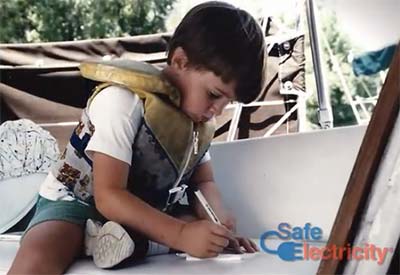Never Swim in a Marina – Lake Fatalities Highlight Need for Electrical Safety

Thankfully, we have not heard any reports of fatalities in Canada, but a recent accident involving a dockside electrocution at Lake Cumberland in Kentucky, along with swimming fatalities over the Fourth of July holiday last year, underscore the dangers when water and electricity mix. The common element in these unfortunate accidents was electrical current entering the water from boats or docks.
"Wet environments are particularly dangerous when it comes to electricity. It's vital to ensure electrical connections on or near the water are properly installed with appropriate safety equipment," explains Molly Hall, executive director of the American Safe Electricity program. "Your loved ones' lives just might depend on it."
Docks with electrical installations should be properly maintained. Even so, it's safest not to swim around docks with electrical power. Experts from the U.S. Electric Shock Drowning Prevention Association (electricshockdrowning.org) say never swim in or near marinas, docks or boatyards.
If you are in the water and start to feel a tingle, swim away from any apparent electrical source and get out of the water as soon as possible without touching any metal objects (such as ladders). For bystanders hearing of a swimmer experiencing a tingle, immediately turn off power to everything you can. Do not jump in to help. You could easily become a casualty yourself.
"Prevent deadly shocks. Check your boats and docks," Hall adds. "If you have not checked your boats and docks yet this year, don't wait. Take the time to do so now. "
Safe Electricity in conjunction with the American Boat and Yacht Council and the International Brotherhood of Electrical Workers/National Electrical Contractors Association in the U.S. recommend that:
At a minimum, all electrical installations should comply with articles 553 (residential docks) and 555 (commercial docks) of the 2011 National Electrical Code which mandates a GFCI on all dock receptacles. A GFCI measures the current in a circuit. An imbalance of that current, such as a discharge into the water, will trip the GFCI and cut off power.
The GFCI should be tested at least once a month or per the manufacturer's specifications. The GFCI should be located somewhere along the ramp to the dock so it can be easily found and tested by local fire departments as needed. The metal frame of docks should have "bonding jumpers" on them to connect all metal parts to a ground rod on the shore. That will ensure any part of the metal dock that becomes
energized because of electrical malfunction will trip the GFCI or the circuit breaker.
Neighbouring docks can also present a shock hazard. Ensure your neighbor's dockside electrical system complies with the National Electrical Code and has been inspected. All electrical installations should be performed by a professional electrical contractor. Because docks are exposed to the elements, their electrical systems should be inspected at least once a year.
When it comes to your boat's electrical system, particularly those with alternating current (AC) systems, follow these tips:
If you are unsure about how to install something, do not call your neighbor/electrician friend. Call an ABYC Electrical Certified Tech. There are some big differences between your house and your boat.
Household wire is not suitable for use on boats as houses are motionless and generally dry. Even marine-rated wire that is not supported along its length will break with constant motion stress. Do NOT use wire nuts or splice connectors! Wire nuts are for solid conductor wire, which should never be on a boat, and splice connectors cut wire strands. Fuses are rated to protect the wire, not the stereo. If a fuse blows continuously, it should NOT be replaced with a larger one just to keep it from blowing again—something else is wrong.
Have your boat's electrical system checked at least once a year. Boats should also be checked when something is added to, or removed from their systems. Also, when boating or fishing be aware of your surroundings and potential overhead electrical hazards. Ensure a distance of at least 10 feet between your boat and nearby power lines. Always lower masts of sail boats before using boat ramps.
Learn more at SafeElectricity.org and www.abycinc.org.




























